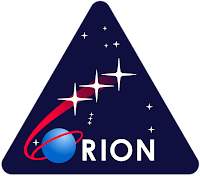International - Lunar Orbital Gateway patch.
March 27, 2020
NASA has selected SpaceX of Hawthorne, California, as the first U.S. commercial provider under the Gateway Logistics Services contract to deliver cargo, experiments and other supplies to the agency’s Gateway in lunar orbit. The award is a significant step forward for NASA’s Artemis program that will land the first woman and next man on the Moon by 2024 and build a sustainable human lunar presence.
Image above: Illustration of the SpaceX Dragon XL as it is deployed from the Falcon Heavy's second stage in high Earth orbit on its way to the Gateway in lunar orbit. Image Credit: SpaceX.
At the Moon, NASA and its partners will gain the experience necessary to mount a historic human mission to Mars.
SpaceX will deliver critical pressurized and unpressurized cargo, science experiments and supplies to the Gateway, such as sample collection materials and other items the crew may need on the Gateway and during their expeditions on the lunar surface.
“This contract award is another critical piece of our plan to return to the Moon sustainably,” said NASA Administrator Jim Bridenstine. “The Gateway is the cornerstone of the long-term Artemis architecture and this deep space commercial cargo capability integrates yet another American industry partner into our plans for human exploration at the Moon in preparation for a future mission to Mars.”
NASA is planning multiple supply missions in which the cargo spacecraft will stay at the Gateway for six to 12 months at a time. These firm-fixed price, indefinite delivery/indefinite quantity contracts for logistics services guarantee two missions per logistics services provider with a maximum total value of $7 billion across all contracts as additional missions are needed.
“Returning to the Moon and supporting future space exploration requires affordable delivery of significant amounts of cargo,” said SpaceX President and Chief Operating Officer Gwynne Shotwell. “Through our partnership with NASA, SpaceX has been delivering scientific research and critical supplies to the International Space Station since 2012, and we are honored to continue the work beyond Earth’s orbit and carry Artemis cargo to Gateway.”
The Gateway Logistics Services contract enables NASA to order missions for as long as 12 years with a 15-year performance period and provides the ability to add new competitive providers. These missions will support NASA’s plans for sustainable exploration with both international and commercial partners, while developing the experience and capabilities necessary to send humans to Mars.
Lunar Orbital Platform-Gateway. Animation Credit: ESA
“This is an exciting new chapter for human exploration,” said Mark Wiese, Deep Space Logistics manager at NASA’s Kennedy Space Center in Florida. “We are bringing the innovative thinking of commercial industry into our supply chain and helping ensure we’re able to support crews preparing for lunar surface expeditions by delivering the supplies they need ahead of time.”
Charged with returning to the Moon in the next four years, NASA’s Artemis program will reveal new knowledge about the Moon, Earth and our origins in the solar system. The Gateway is a vital part of NASA’s deep space exploration plans, along with the Space Launch System (SLS) rocket, Orion spacecraft, and human landing system that will send astronauts the Moon. One standard logistics service mission is anticipated for each Artemis SLS/Orion crewed mission to the Gateway. Gaining new experiences on and around the Moon will prepare NASA to send the first humans to Mars in the coming years, and the Gateway will play a vital role in this process.
“We’re making significant progress moving from our concept of the Gateway to reality,” said Dan Hartman, Gateway program manager at NASA’s Johnson Space Center in Houston. “Bringing a logistics provider onboard ensures we can transport all the critical supplies we need for the Gateway and on the lunar surface to do research and technology demonstrations in space that we can’t do anywhere else. We also anticipate performing a variety of research on and within the logistics module.”
Related articles:
NASA Selects First Science Instruments to Send to Gateway
https://orbiterchspacenews.blogspot.com/2020/03/nasa-selects-first-science-instruments.html
European Gateway experiment will monitor radiation in deep space
https://orbiterchspacenews.blogspot.com/2020/03/european-gateway-experiment-will.html
Lunar Gateway: Earth’s guard post against asteroids?
https://orbiterchspacenews.blogspot.com/2020/03/lunar-gateway-earths-guard-post-against.html
Angelic halo orbit chosen for humankind’s first lunar outpost
https://orbiterchspacenews.blogspot.com/2019/07/angelic-halo-orbit-chosen-for.html
NASA to Partner with American Industry to Supply Artemis Moon Missions
https://orbiterchspacenews.blogspot.com/2019/06/nasa-to-partner-with-american-industry.html
NASA Awards Artemis Contract for Lunar Gateway Power, Propulsion
https://orbiterchspacenews.blogspot.com/2019/05/nasa-awards-artemis-contract-for-lunar.html
Gateway to the Moon
https://orbiterchspacenews.blogspot.com/2019/03/gateway-to-moon.html
NASA Secures First International Partnership for Moon to Mars Lunar Gateway
https://orbiterchspacenews.blogspot.com/2019/03/nasa-secures-first-international.html
Related links:
Artemis: https://www.nasa.gov/artemisprogram
Moon to Mars: https://www.nasa.gov/topics/moon-to-mars/
Lunar Orbital Platform-Gateway: https://www.nasa.gov/topics/moon-to-mars/lunar-outpost
Commercial Space: http://www.nasa.gov/exploration/commercial/index.html
SpaceX: https://www.spacex.com/
Image (mentioned), Animation (mentioned), Text, Credits: NASA/Sean Potter/Gina Anderson/JSC/Isidro Reyna/KSC/Amanda Griffin.
Greetings, Orbiter.ch


















































